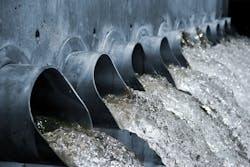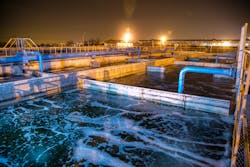Water monitoring trends: Taking action to achieve production and sustainability goals
The water industry is getting a lot of attention right now. It is great to see not only infrastructure but also quality, conservation and regulation in the headlines. There is a lot of passion around water, and companies are setting high standards and metrics for water efficiency as corporate drivers. We also see more interest than ever on the consumer side. Consumers are placing greater value on quality and sustainability over price, which results in the cost of quality increasing for producers. With the rising focus from both corporations and consumers, the current challenge for water professionals and water users (everyone) is to move from passion to action.
Water monitoring is a critical tool to help achieve production and sustainability goals, as well as improve process control. It is important to track the contaminants or contaminant classes that affect treatment effectiveness, product quality or equipment assets. Being able to easily measure and consequently minimize organic contamination can help prevent product loss and gain better process understanding. Let’s look at some actions we can take.
Get more out of technology and data
New technologies have emerged to help track and treat existing and emerging contaminants. In addition, data visualization tools are increasingly used to assess trends and predict performance. Together, these analytical technologies and data visualization tools help to set corporate performance indicators. Yet, there must be a purpose behind the tracking and trending. Data for data collection sake is inefficient, and data is not useful without interpretation. Thus, there is a need for simple tools to turn data into action.
Ensure water is fit for purpose
There is also now a consensus that all water is one water. This means that utilities and companies must align their goals since all are sharing this single resource. However, water has a variety of uses and purposes, each with allowable quality or contamination. Treating and tracking water for its specific purpose is critical to optimizing the resource and the time, energy and labor going into the treatment.
Track contaminants efficiently and effectively
With the increased demand on this limited resource, a tool that captures and tracks contaminants is extremely valuable to operators and facility owners and enables them to commit to actions that lead to data-driven decisions. One such tool captures all organic compounds and tracks all carbon-containing contaminants. Carbon readily exists in products and processes used in various industries, including chemicals, food and beverage, and pharmaceuticals, but carbon is also found in contaminants of concern when these chemicals and pharmaceuticals get into the environment. Organic matter makes up the majority of contamination entering municipal treatment facilities and commonly contains plant and animal decay, as well as industrial effluents. With all these different organic compounds and contaminants, tracking them together in a sum parameter can be critical to success in productivity and compliance in many ways.
Here are some examples of various scenarios where it is beneficial to monitor organics to meet quality and/or compliance requirements:
- Drinking water from a river needs to meet specific criteria for human health.
- Wastewater discharge from a chemical factory needs to not harm the environment.
- Boiler feedwater at a beverage facility needs to not damage equipment and not contain product.
- Ultrapure water at a semiconductor fab needs to be free of organic acids or bases that could affect chip manufacturing.
Align with real-world challenges
Let’s take each of these examples and walk through how a simple monitoring tool can help turn data into action. These scenarios all have very different water quality criteria that make the source specific to the purpose.
Water from a river
Drinking water from a river needs to adjust to seasonal variations and changes to the source makeup. Most contaminants to be removed are natural organic matter (NOM) unless the river is downstream of an industrial facility or the NOM has broken down to become food for microbial growth. Tracking the weather and industrial influence directly leads to treatment action over the short term (i.e., changing the chemical amount) to long term (i.e., expanding or retrofitting for new technologies). While specific microbial or emerging contaminant testing are critical for plant setup and occasional testing, there needs to be a quick and easy analytical tool that can be used on a daily basis to provide accurate, reliable and robust information. Tracking and trending the organic chemical load, natural organic matter and potential organic food for microorganism growth yields actionable data.
Chemical plant wastewater
Boiler feedwater at a beverage facility
A beverage manufacturer needs purified water to generate steam as part of its production. The manufacturer may recycle some of the condensate back to boiler feedwater and combine it with source water as the makeup. The feedwater needs to be highly purified to avoid scaling, deposition or corrosion to the plant equipment. This means any cooling fluids, source water contaminants and ingredients need to be kept out of that feed. With goals of reusing and recycling, it is critical to establish reliable monitoring at the point where streams are combined. Beverage ingredients stem generally from organic compounds as they include flavors, dyes and sugars. Cooling fluids such as glycol or environmental cooling water can also carry organic contaminants. The challenge with these organics is that, at high temperatures and pressures, they can break down to corrosive organic acids and, if from the ingredient side, lead to product loss. Tracking organic excursions helps plants make rapid decisions with regard to potential reuse, makeup water and, ultimately, equipment protection.
Ultrapure water at a semiconductor fab
Semiconductor fabrication requires extremely pure water — and a lot of it. The technology required to obtain the needed purity is complex and expensive. It also requires every step to be precisely controlled because the water that does meet the chip must be free from any contamination. Chemicals in the treatment, and their byproducts from treatment, break down and are closely monitored so they do not affect processes. Monitoring all organics, especially those critical organic acids and bases, provides data that is used in critical decision-making in order to optimize yield. In addition, there are multiple other uses for water across a semiconductor facility beyond chip manufacturing. Water is also critical in cooling, tool handling, washing and cleaning. The increased demand for production means increased demand for water, which can strain local relations with water utilities and populations. Recent efforts in reclaim and reuse will only continue to grow to meet these demands.
Conclusion
Knowing and understanding water’s purpose makes the step from driver to action much simpler. This can be accomplished using comprehensive organics monitoring to reveal not only quality achievements but also efficiencies to be gained. “Following the carbon” by tracking different organic compounds and contaminants throughout a process enables companies to answer the question of what their water is telling them. This applies across many industries and applications, including drinking water, beverage manufacturing, power generation, steam production and ultrapure water in semiconductor manufacturing.
We have a finite amount of water that is needed for countless purposes, so it is imperative that we understand and optimize water quality to ensure it is fit for use and best used. The more we can connect drivers and passions for sustainability and environmental compliance with meaningful monitoring data, the better we can deliver on our commitments and improve our use of this universal resource.
About the author: Amanda Scott leads the Industrial & Environmental product team for the Sievers product line of TOC analyzers by SUEZ – Water Technologies & Solutions. In this role, Scott develops and supports innovative monitoring solutions to help industries and municipalities meet their quality, compliance and control goals. She has been published in more than five trade journals and has presented at over 20 different national and international water conferences. Scott has a master’s in chemical engineering from University of Cambridge and a bachelor’s in chemical engineering from Vanderbilt University.

